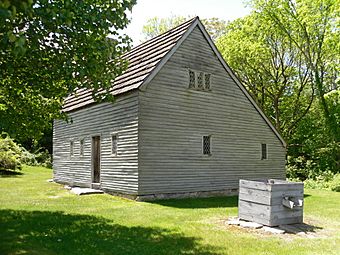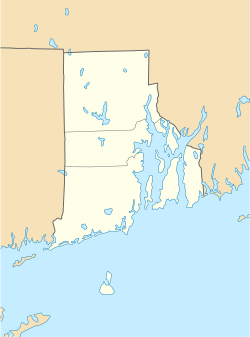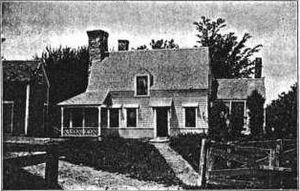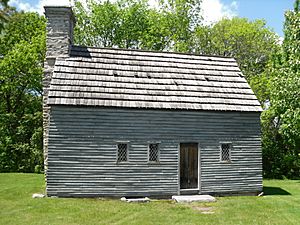Clemence–Irons House facts for kids
Quick facts for kids |
|
|
Clemence–Irons House
|
|

The non-stone ender side of the house.
|
|
| Location | 38 George Waterman Road, Johnston, Rhode Island |
|---|---|
| Built | 1691 |
| Architectural style | Stone Ender |
| NRHP reference No. | 73000068 |
| Added to NRHP | July 2, 1973 |
The Clemence–Irons House is a very old and special house in Johnston, Rhode Island. It's also called the Edward Manton House. Richard Clemence built it way back in 1691. This house is a rare example of a "stone ender" home. These types of houses were first built in England. They became popular in early Rhode Island. Today, the house is on the National Register of Historic Places. This means it's an important historical site. It's now a historic house museum run by Historic New England. You can visit it on Saturdays from June to mid-October.
Contents
History of the Clemence–Irons House
Richard Clemence, who was a farmer, built the Clemence–Irons House in 1691. Over many years, the house had different owners. By 1938, it had grown quite a bit. It had 13 rooms! Henry Sharpe and his sisters, Ellen Sharpe and Louisa Sharpe Metcalf, bought the house that year.
The house had many additions by then. These included a new living room with its own fireplace. There was also a second "lean-to" section. This part had a kitchen, bathroom, and two bedrooms. A small wing was added to one corner. There was also a front hall and porch.
Restoring the House
Even with all the changes, the Sharpe family knew the house was very old. They also recognized its special "stone-ender" style. They hired Norman Isham to help. Isham was an expert who had restored another old house nearby. His job was to study the Clemence–Irons House. He would then restore it to look like it did in the 1600s.
Isham discovered that the original house had one and a half stories. It also had a lean-to at the back. The roof was very steep. He found clues that the first floor had four rooms. This was different from most early stone-enders, which often had just one room.
To restore the house, later additions were removed. Non-original parts inside were taken out. The house was then rebuilt to match Isham's findings. The main part of the house now has a large "great room" and a bedroom. The back lean-to has a kitchen and a smaller bedroom.
Isham used a mix of old and new materials. This helped to make the house look original. He even had furniture made from old wood. This furniture matched the old style of the house.
Why the House is Important
The Clemence–Irons House is one of the oldest homes in Rhode Island. It's also important because it shows how old buildings were restored in the mid-1900s. The house was given to the Society for the Preservation of New England Antiquities in 1947. This group is now called Historic New England.
In 2003, scientists studied the tree rings in the house's wood. This method is called dendrochronology. They confirmed that the house was built in 1691. The Clemence–Irons House, along with the Eleazer Arnold House, helps us learn about "stone-ender" homes in New England.
See also
- List of the oldest buildings in Rhode Island
- Eleazer Arnold House, another nearby Rhode Island stone-ender owned by Historic New England
- National Register of Historic Places in Providence County, Rhode Island





